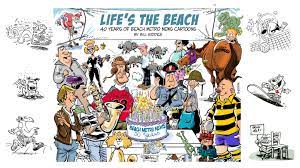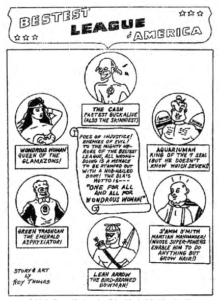Cartoonists in the News
Skip to commentsBill Suddick, Chuck Asay, Kate Beaton, Roy Thomas, Edward Sorel, and Jackie Ormes.
Beach Metro Community News cartoonist, illustrator and educator Bill Suddick will be the guest speaker at the Tuesday, March 22, online event hosted by The Beach and East Toronto Historical Society.
The free Zoom presentation will feature Suddick talking about the stories and characters of his 40 years as Beach Metro Community News editorial cartoonist.
Earlier this year, Suddick released his book of cartoons called Life’s the Beach. The book celebrates his more than 40 years of cartooning and Beach Metro Community News’ 50th anniversary which is taking place this year.
Story and details at Beach Metro News.
The Chuck Asay name and art were the voice and face of The Gazette’s political cartoons for more than 20 years.
Readers always had strong love or hate relationships with Asay and his cartoons and made their views known. Several times there were demonstrations and protests outside the Gazette building against Asay’s stands. In one case, Publisher E. Roy Smith told him to stay home that day rather than try to walk through a crowd to get in the front door.
All of his Gazette cartoons are in Special Collections at Penrose Library, where with Chuck’s help it lightheartedly describes the collection as “inflicting his religious, right-wing, wacko views on people. He believes we live in a free country where everyone is entitled to his (Chuck’s) opinion.”
The Colorado Springs Gazette catches up with their former editorial cartoonist.
Pair a young princess with plenty of moxie and a flatulent pony, and you’ve got the basis for a show that will please viewers of every age.
That’s the hope for the new Apple TV show Pinecone & Pony, based on the Children’s Book Award-winning story The Princess and the Pony by Mabou-based cartoonist Kate Beaton.
Beaton’s charming story of young warrior Princess Pinecone and the doughy, big-eyed pony she gets for her birthday — instead of the sleek, majestic warhorse she was hoping for — was, to put it mildly, a hit. Published by Scholastic Books, it made several year-end best books lists in 2016 and paved the way for her second award-winning kids’ volume, King Baby.
Kate gets animated discussing her new project with SaltWire.
The toughest part about interviewing Roy Thomas is what not to ask him about.
Thomas’ career spans such a large swath of comics history, it would take multiple interviews to cover even half of his legacy’s high points. And he’s not even close to being done.
Few creators can match Thomas’ list of credits. He has scripted just about every superhero in the Marvel Comics library, as recently as 2020 although his first published work for the company was a feature in a 1965 romance comic, Modeling with Millie #44. Speaking of the Marvel archives, it would be much barer without Thomas. He had a hand in creating gobs of prominent heroes and villains that endure in comics, film and television, including the Vision, Luke Cage, Carol Danvers, Adam Warlock, Daimon Hellstrom, Morbius, Valkyrie, Ultron, Yellowjacket and super-teams like the Defenders, the WWII-era Invaders and Marvel’s answer to the Justice League, the Squadron Supreme.
Mike Avila, for SyFy Wire, goes in deep with a Roy Thomas profile/interview, though not enough to cover his fanzine days or the nearly two decades ghost writing The Amazing Spider-Man comic strip.
Ed Sorel is an illustrator, caricaturist, cartoonist, graphic designer and author. Formerly a regular contributor to The Nation, New York Magazine and The Atlantic, his work is today seen more frequently in Vanity Fair.
[H]e created stinging caricatures of powerful people. You’d think they’d complain. You’d be wrong. “These people are delighted to be made fun of by the ridiculous people who think that they’re so funny.
Person Place Thing with Randy Cohen interviews Ed discussing his Moses drawing, Art Young, art director Graydon Carter, murals, his Edward G. Robinson caricature, and more.
In the comic strip Torchy Brown from Dixie to Harlem, a spunky Black teenager leaves her Mississippi home for the bright lights of Harlem. She’s glamorous, ambitious, clever, and so self-assured that when she sees a sign pointing one way for COLORED and another way for WHITE, her response is, “I’ll just pretend I can’t read very well.” It was 1937, twenty years before anyone ever heard of Rosa Parks, and the author of the comic was a Black woman, Jackie Ormes.
A true trailblazer, Ormes was way ahead of the curve. “I have never liked dreamy little women who can’t hold their own,” she stated in an interview at the end of her life. Not only did Ormes transform stereotypes of the Black maid and the pickaninny into smart, assertive, attractive heroines, but she also created positive images of strong, sexy Black women, paving the way for Black is Beautiful and #BlackGirlMagic.
Victoria Linchong, for Messy Nessy, takes an extended look at Jackie’s career.







Comments
Comments are closed.